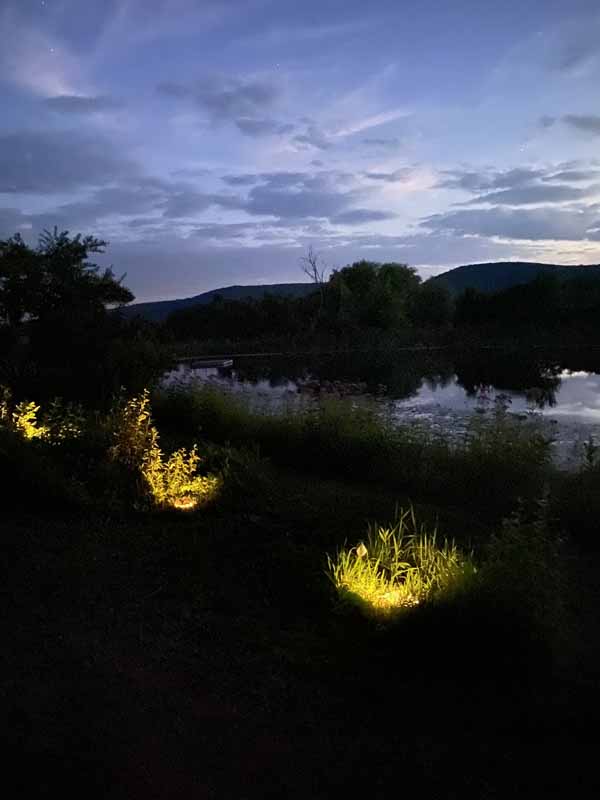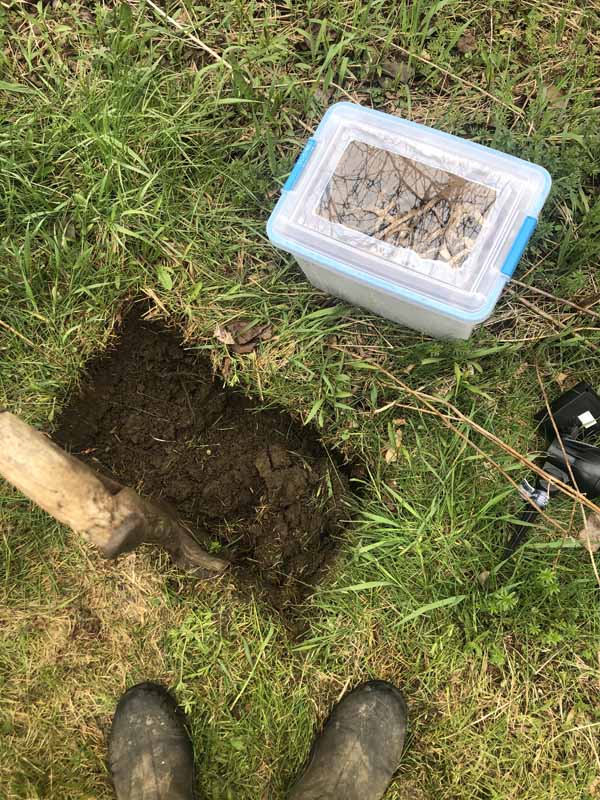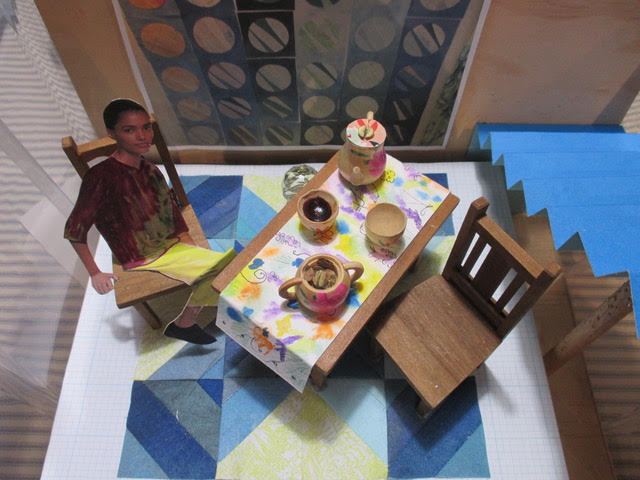Together in Isolation, an art installation
The Re Institute is an art gallery and installation space set indoors and outdoors on a 32-acre farm in rural Dutchess County (New York State), near the corner of New York, Connecticut, and Massachusetts. More specifically, it stands on Boston Corners Road in Millerton, NY, about 2 hours north of New York City. It’s run by curator/artist Henry Klimowicz who produces edgy and interesting shows for contemporary art lovers.
///////////
The current show is titled “Together in Isolation,” which gathers local, national and international artists to address the personal issues rising from the pandemic which gives the show its name. And the concept is a unique one. Artists create their art which is placed in clear plastic, lidded storage boxes. The artwork containers (vitrine) are then buried up to their lids on the grounds of the Re Institute and can be seen by walking to each piece and looking down into them. The “together in isolation” exhibition is created. A solar light is buried near the front side of each box allowing the pieces to be viewed at dusk or at night, which curator Klimowicz says is the best way to take in the artworks.

///////////
Dominique DeVito, writing in the MainStreet Magazine, said,
“Get thee to the Re: How cool is an exhibition of art that is outside at night? How fantastic to arrive at an old farm at dusk, a sliver of a moon perched in an indigo sky – a tableau wonderful enough in itself to be the experience – the magic of the night just starting to unfold? How amazing for an artist to transform his land and home into a statement about the precariousness of our times with this inside-out experience? It’s so cool and so fantastic and so amazing and so original that, well, you simply must go.” info@mainstreetmag.com
Julie Baumgardner of Artnet news wrote in August 2020:
Henry Klimowicz’s The Re Institute in Millerton, New York, has operated on the fringe of the Hudson Valley scene since 2009, exhibiting artists such as Judy Pfaff, Todd Chandler, and Letha Wilson. Klimowicz is currently showing one of the most thoughtful upstate shows, “Together in Isolation.”
///////////
The show is open to the public as an outdoor walking experience. The Gallery is open Wednesday and Friday evenings from 7:15pm to 8:15pm and Saturday from 1pm to 4pm by appointment only. The appointments start every 15 min. This allows groups to arrive in over a one-hour window. Once you are here you can take as long as you want to visit the show. The evening hours will change as the day shortens. Visitors should continue to check for viewing times.
///////////
Klimowicz states the objective of the exhibition:
To continue creativity while participating in an exhibition that mirrors our collective experiences. To produce a long-term record of this time of isolation, hardship, and sadness. To find glimmers of hope. It’s open call to all artists of all mediums to participate safely in a group exhibition.
I foresee a time when people could view the installation in very low numbers. This will only happen when the public can go to outdoor spaces once again in New York State. The gallery will set up a timed entry method using an online calendar. The guests will walk the grounds as they follow a map or just roam. The boxes are buried in the ground with just the top window visible. The solar light is buried to one side of each box with its
solar collector just above the ground. Each piece has a flag marking its spot in the environment. At night the landscape gently glows from the indirect light of the buried boxes.
The exhibition is seen as a permanent documentation of our times. The exhibition will formally end when we can gather in a large group and have a closing party. After this end event the exhibition will be dug up and stored. If in the future, a venue can be found the exhibition will be reburied. To facilitate these long term hopes the works of art will not be returned to the artist, nor will they be for sale.
//////////
The overall exhibition is intended to be an ongoing record of this time. Art works will be accepted through out the life of the exhibition. An annotated list of the participating artists whose boxes have been installed are listed with their accompanying photos and videos of the works in progress available on the website. The drop off of the boxes can be done by mail or as a curbside pickup/drop off. Artists wishing to participate should visit the Re Institute website: TheReInstitute@gmail.com for specific details.

On The Re Institute website, curator Klimowicz continued his thoughts on the show:
1. Everyone is an artist.
2. We are all working alone, each of us in our own studio/home. The isolation of our studios is echoed in the placement of the boxes across the landscape.
3. The box is chosen for its versatility to all artistic art processes. The box will allow artists that normally do not make outdoor work to also participate in this exhibition. A drawing, a painting, a photograph, or a poem placed in the bottom of the box could all work to capture these times.
4. We all dream of being back in a world where our art can be experienced by others. The architecture of these dreams is often the white walled rooms of a gallery. A space where our friends all gather to see what we have made. The box and its interior space is a metaphor for this architecture that we dream of.
5. We strive to record our lives and to bring meaning to the present. We do this through the production of artifact. Some of the work presented may talk directly to the experience of loss and isolation. Other pieces may be the record of one artist’s present interests. Some may be a wonderful treasure that the finder/participant will be given as reward for their search.
6. This may be a time of mass burial. The small cemetery near where I live recently set out flags demarcating the rows for future grave sites. This exhibition with its individual art objects may stand in for a similar act of reverence.
7. As humans, what we bury has always been deeply important to us. Think of the amazing Ice Age carving of swimming reindeer at the British Museum. The reindeer sculpture has no practical purpose. Yet it completely links us with humanity 50,000 years ago.
8. The landscape will not be changed by this installation. The lands natural beauty will still be the most prominent aspect of what one sees in the environment. This will echo the way public spaces now feel, empty of human presence.
//////////
As publisher of Lightwood, I was taken with this insightful and often moving show. I saw it when visiting there with my wife, Kay Stuntz, a fabric artist and a friend, costume designer and historian, David Roberts. Another friend, artist Kate Hamilton, had a piece in the show. With no other visitors present on that late afternoon, Henry Klimowicz, walked us through the exhibition, detailing the pieces and talking about the concept. We were so intrigued with what we saw, artworks so personal and yet so universal, that we asked if we could “buy a box” and contribute to the show. And we did.
////////


Sounds wonderful! For those of us who would need get on airplane to view the exhibition in person, will there be (or is there) a virtual tour?
LikeLike
I’m not sure there will be a virtual tour of the Re Institute yet- Perhaps in the Spring, when more people will wany to be out. Henry is planning on continuing the show and have a gala sometime next year.
LikeLike